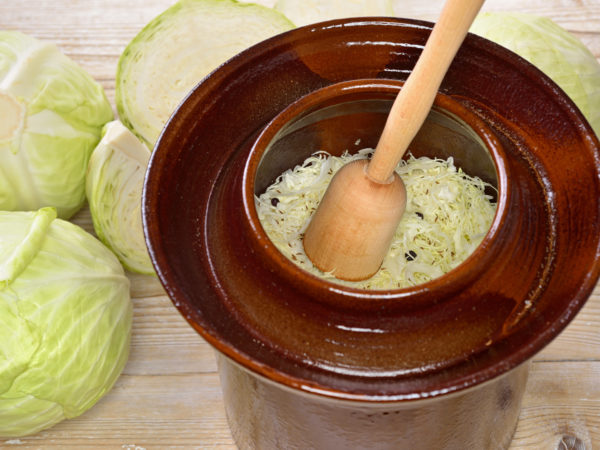Dr. Weil's Homemade Sauerkraut

As his last name suggests, Dr. Weil’s ancestry is German, and as a child in Philadelphia, he feasted on traditional old-country dishes. While his research into healthy eating has prompted him to leave the schnitzel and spatzle behind, one Teutonic staple remains dear to his heart: sauerkraut. But be aware: Dr. Weil’s version is not the pasteurized, mushy imposter that taught many Americans to hate the stuff.
“The canned kind is just awful,” he says, shaking his head. “Real sauerkraut is an entirely different food. A living food. We used to get it from barrels at the German delis in Philadelphia.”
But such delis are few and far between in southeastern Arizona, so on the butcher-block island in Dr. Weil’s kitchen stand two traditional sauerkraut-making pots. One is 18 inches tall, the other 14 inches, and each is colored with deep brown ceramic glaze. (Such pots are widely available online – a search on “sauerkraut crock pots” should bring up many different varieties to choose from.)
Sauerkraut at Home:
Making sauerkraut at home, with or without special equipment, is “really quite simple,” says Dr. Weil. “First, I get fresh cabbage from the garden, shred it and mix it in a bowl with salt,” at a ratio of roughly 3 tablespoons of salt for every five pounds of cabbage. “I load it into the crocks and really pack it down with my fist.” He then puts a pair of half-circle-shaped ceramic weights (which are sold with the crock; a water-filled bottle set atop a plate will also work) on top of the cabbage and puts on the lid.
A unique feature of a sauerkraut crock is that the lid’s edge sits in a circular trough that can be filled with water. This forms a one-way seal: carbon dioxide given off by fermentation can bubble out, but air cannot get back in. Sauerkraut can be made in a glass or ceramic vessel without such a seal, but tends to form a mold on the brine’s surface that requires regular skimming or the batch will spoil.
The salt draws water from the cabbage. Because Dr. Weil uses only garden-fresh cabbage, a brine usually forms in a few hours. But if, after 24 hours, enough brine has not formed to cover the cabbage, which can happen with older, drier vegetables, “you can just add salted water,” at a concentration of roughly one teaspoon of salt per cup.
Dr. Weil lets the batch sit at room temperature for three days, which is why the crocks were in the center of his kitchen. “It starts this weird bubbling. Then I move it back to a cooler location for about six weeks. That’s all there is to it.” Sauerkraut can be sampled just a week or so after fermentation starts, but the flavor improves over time. Once it tastes just right, the finished product can go into the refrigerator, packed in its own juice, for several weeks more.
Fortunately, I did not have to take the good doctor’s word for how wonderful homemade sauerkraut can be. He keeps his crocks in productive rotation, and served up a bowl of the previous batch for each of us.
Revelation! Redemption! Black-Forest epiphany! Mein Gott in Himmel, that’s good sauerkraut! Where the canned version I recalled from my own German-American childhood tasted like an unholy mélange of salt, vinegar and mush, Dr. Weil’s sauerkraut was a Wagnerian symphony of crunchy textures and vibrant, piquant flavors. The transformation of bland cabbage and plain salt into sour nirvana is the work of lactic acid, produced when Lactobacillus bacteria, which is already present in the cabbage, digests sugars in the vegetable.
So is it healthy? “There is a range of salt concentrations you can use, and I tend toward the minimum,” says Dr. Weil. “So unless you need to restrict your salt intake for some specific reason, that’s not a concern.” But be aware – too little salt can lead to spoilage and food poisoning. Don’t go below three-tablespoon-per-five-pound limit, and never eat sauerkraut that is slimy, excessively soft, discolored or off-flavor.
On the positive side, “Fermenting does some of the digestive work for you, so it makes a lot of foods more digestible and the nutrients in them more bioavailable,” says Dr. Weil. Sauerkraut is an excellent source of vitamin C, which is why Captain James Cook reportedly took it on his sea voyages to prevent scurvy. Fermented foods are said to populate the digestive tract with healthful microorganisms, and some reports say parts of the world with a high percentage of centenarians tend to use fermented foods in abundance. In any case, fresh, living sauerkraut is low in calories and fat, high in fiber, cheap, fun to make and decidedly köstlich – delicious!











